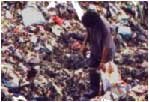
|
Livelihood
OF THE almost 500,000 residents, about 4/5 live in the informal settlements. The population over the years is booming .
The continuous migration of squatters to the area is alarming. A relatively high birth rate also contributes to the population boom. Women give birth amidst Manila's refuse, without safe water, electricity or
professional help.
The mortality rate, not counting the June 10 disaster, has slowly climbed as well. The leading causes of mortality come from disease such as : diarrhea, upper respiratory tract infection, myocardial infraction, hypertension, pneumonia, TB, and malnutrition. At least 35% of the children suffer from 1st to 3rd degree malnutrition.
The majority finds income through scavenging the dump. Women, men and children scavenge the waste from dawn to dusk, collecting cans, plastic, scrap metals,
bottles and newspapers to earn 60-70 pesos per day. The minimum needed by a family of six (the average
size of a Filipino family), as calculated by the National Economic Development Agency, is 250 pesos per
day.
It is not the smell that is deadly; it is the toxic fumes rising from decomposing plastic, bottles and scrap.
People on the scrap heaps die at about 40 years because of these fumes.
Companies require at least high school level education before they hire. Parents in most urban poor
communities do not have the money to enrol their children in high school. Life is hard in Payatas.

|

Scavenging

Boy on bags of garbage
|























